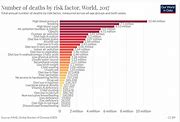The world of healthcare is constantly evolving, with new challenges emerging every day. One such challenge that has been gaining attention in recent years is antimicrobial resistance (AMR). The rise of AMR poses a significant threat to global public health, making common infections harder to treat and increasing the risk of severe illness or even death.
According to the Global Burden of Disease (GBD) 2021 Antimicrobial Resistance Collaborators, the analysis of bacterial AMR from 1990 to 2021 provides valuable insights into the current trends and future projections. The findings indicate a concerning trajectory, with AMR mortality expected to surge in the coming years. This alarming trend suggests that we may have reached a critical turning point in the fight against antimicrobial resistance.
In light of these projections,
experts emphasize the urgent need for proactive measures to address AMR effectively.
As one expert notes,
“Continued reliance on mitigation through prevention and stewardship is crucial but may yield diminishing returns as we have already made significant progress.”
This underscores the importance of exploring alternative strategies to combat AMR.
One key recommendation highlighted by researchers is the improvement of access to antibiotics worldwide. By enhancing accessibility, it is estimated that over 50 million deaths could be prevented globally. However, disparities in antibiotic availability persist across regions, particularly affecting populations in low-income countries and sub-Saharan Africa.
The systematic analysis also sheds light on the impending rise of Gram-negative infections, which are notoriously challenging to treat due to their resistance mechanisms. To tackle this growing concern effectively, experts suggest intensifying research efforts and developing targeted interventions tailored to combatting these elusive bacteria strains.
Additionally, special attention must be directed towards vulnerable populations such as neonates who face unique risks associated with limited vaccine options and scarce antibiotic treatments. Despite advancements in healthcare for older age groups, newborns remain at high risk due to their physiological vulnerability and limited treatment options available for this age group.
As healthcare continues to evolve rapidly, stakeholders must prioritize addressing antimicrobial resistance as a global health priority. By fostering collaboration among researchers, policymakers, healthcare providers, and communities worldwide, we can work towards innovative solutions that safeguard public health from the escalating threat posed by antimicrobial resistance.
In conclusion, combating antimicrobial resistance requires a multi-faceted approach encompassing enhanced antibiotic access, targeted research initiatives focusing on hard-to-treat pathogens like Gram-negative bacteria,
and tailored interventions for high-risk populations such as neonates. Through concerted efforts and strategic planning,
we can mitigate the impact of AMR
and ensure a healthier future for generations
to come.

